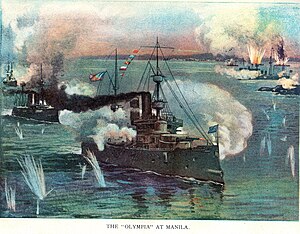Asiatic Squadron
This article needs additional citations for verification. (November 2010) |
| Asiatic Squadron | |
|---|---|
 The Asiatic Squadron defeating the Spanish fleet in the Battle of Manila Bay on 1 May 1898. | |
| Active | 1868–1902 |
| Allegiance | |
| Branch | |
| Type | Naval squadron |
The Asiatic Squadron was a
History
Korean Expedition
In May 1871,
On 1 June 1871, while Rear Admiral Rodgers was negotiating in
Spanish–American War

On 27 April 1898, the squadron, composed of the
In the

On 20 June 1898, the Asiatic Squadron protected cruiser USS Charleston captured Guam from the Spanish without resistance, beginning the American possession of the island.
Philippine–American War
The Asiatic Squadron participated in the Philippine–American War from 1899 until its disbandment in 1902. American naval forces operated by sending landing parties ashore and by providing them with naval gunfire support. From 1899 to 1902, the squadron conducted several missions against the Filipinos.
Dewey's squadron engaged in naval operation against the Filipinos during and after the 1898 Battle of Manila against the Spanish. At the beginning of the Philippine–American War in February 1899, several American warships supported the occupation of the Philippine Islands. At the same time, the

Many of the captured Spanish gunboats used in the Philippine–American War were manned by
Baltimore and Petrel served at the
On 7 May 1899, Laguna de Bay and another gunboat
, where they bombarded Filipino positions in the town and sent men ashore to fight on the ground. Again the Filipinos retreated and set several buildings on fire as they went.In June 1899, American gunboats silenced an artillery piece during the Battle of Zapote River, which ended with an American victory.

In the summer of 1899, American gunboats started patrolling
Charleston grounded on an uncharted reef off
On 7 November 1899, Helena
Asiatic Squadron gunboats took part in the Battle of Mabitac in June 1900, where they bombarded Filipino forces while U.S. Army troops attacked their fortifications. In a bloody frontal assault the American troops were repulsed and the Filipinos won the battle.
In November 1900, the Asiatic Squadron
The gunboat
Boxer Rebellion
During the Boxer Rebellion, the Asiatic Squadron participated in the China Relief Expedition in 1900. At the time, Peking was home to many foreigners who were under siege by Boxer rebels. An international force including U.S. Marines and U.S. Navy sailors of the Asiatic Squadron slowly fought their way to take control of Tientsin away from the Boxers in order to relieve the Siege of the International Legations at Peking.
Asiatic Fleet
In 1902, the Asiatic Squadron was upgraded in status, becoming the United States Asiatic Fleet. Except for a period from early 1907 until 28 January 1910 when it was downgraded to the status of First Squadron, United States Pacific Fleet, the Asiatic Fleet replaced the Asiatic Squadron in defending American interests in East Asia from 1902 until February 1942.
Commanders


Successive Commanders-in-Chief of the Asiatic Squadron were as follows:[1]
- Rear Admiral Henry H. Bell( – 11 January 1868)
- Commodore John R. Goldsborough (11 January 1868 – 18 April 1868)
- Rear Admiral Stephen C. Rowan(18 April 1868 – 19 August 1870)
- Rear Admiral John Rodgers(19 August 1870 – 12 May 1872)
- Rear Admiral Thornton A. Jenkins (1 September 1872 – 12 December 1873)
- Rear Admiral Enoch Greenleafe Parrott (12 December 1873 – 12 January 1874)
- Commodore Edmund Colhoun (12 January 1874 – 29 May 1874)
- Rear Admiral Alexander Mosely Pennock (29 May 1874 – 24 June 1875)
- Commander Robert F. R. Lewis (24 June 1875 – 16 August 1875)
- Rear Admiral William Reynolds (16 August 1875 – 12 August 1877)
- Captain Jonathan Young (12 August 1877 – 4 October 1877)
- Rear Admiral Thomas H. Patterson (12 August 1877 – 11 September 1880)
- Rear Admiral John M. B. Clitz (11 September 1880 – 21 April 1883)
- Rear Admiral Peirce Crosby (21 April 1883 – 30 October 1883)
- Captain Joseph S. Skerrett (30 October 1883 – 19 December 1883)
- Commodore/Rear Admiral John L. Davis (19 December 1883 – 22 November 1886)
- Rear Admiral Ralph Chandler (22 November 1886 – 11 February 1889)
- Rear Admiral George E. Belknap(4 April 1889 – 20 February 1892)
- Rear Admiral David B. Harmony (20 February 1892 – 7 June 1893)
- Rear Admiral John Irwin (11 June 1893 – 11 December 1893)
- Rear Admiral Joseph S. Skerrett (11 December 1893 – 1 September 1894)
- Commodore/Rear Admiral Charles C. Carpenter (1 September 1894 – 21 December 1895)
- Commodore Frederick V. McNair Sr.(21 December 1895 – 3 January 1898)
- Commodore/Rear Admiral/Admiral George Dewey (3 January 1898 – 20 May 1899)
- Commodore/Rear Admiral Albert S. Barker ( 20 May 1899 – 20 June 1899)
- Rear Admiral John C. Watson (20 June 1899 – 19 April 1900)
- Rear Admiral George C. Remey (19 April 1900 – 1 March 1902)
- Rear Admiral Frederick Rodgers (1 March 1902 – 29 October 1902)
Gallery
-
A posed photograph of Asiatic Squadron officers holding a council of war aboardJohn Rodgersleans over the table at right.
-
USS Olympia at the Independence Seaport Museum in 2007
-
USS Olympia in 1902
-
USS Baltimore in 1891
See also
- China Squadron and Fleet
- Far East Fleet (United Kingdom)
References
- ISBN 1-55750-883-6, pp. 317–318.




